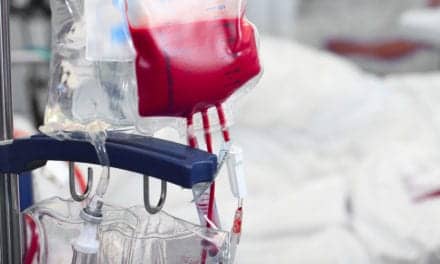In findings that may eventually change the way breast cancer is evaluated and treated, a new study reports that the BluePrint genomic test by Agendia, Irvine, Calif, provides more accurate information about the molecular subtype of a specific breast cancer, compared to the use of conventional immunohistochemistry (IHC)-fluorescence in situ hybridization (FISH) pathology tests.
The prospective observational study of 426 patients was recently published online by the Annals of Surgical Oncology.1 It concludes that the BluePrint assay may be a better guide than IHC-FISH tests in making decisions about how to treat early-stage breast cancer before surgery.
Researchers also reported that the 80-gene BluePrint test reclassified 22% of tumors overall—more accurately identifying breast cancer subtypes than could be done with IHC-FISH testing.
“This genomic test gives us a better picture of which patients will and won’t respond to preoperative therapy, and also helps suggest the best course for therapy,” says Pat Whitworth, MD, a Nashville surgical oncologist and lead study author.
The BluePrint test is performed in conjunction with Agendia’s 70-gene MammaPrint test. MammaPrint provides the fundamental risk classification of high-risk or low-risk for breast cancer recurrence, without the ambiguity of intermediate results. Additional therapy-predictive information is then conferred by the 80-gene BluePrint assay, which identifies the molecular subtype of the cancer.
“One implication of the study findings is that we will eventually end up evaluating and treating many breast cancer patients differently than we do now, because we will rely on their molecular subtype rather than just IHC-FISH pathology results,” says Whitworth.
Such a change would represent a substantial shift in how breast cancer is analyzed and treated, according to oncologist Neil Barth, MD, Agendia’s chief medical officer. “Physicians have for nearly 40 years looked to the predictive capabilities of pathology tests such as IHC and FISH to generate clinical decisions,” he says. “But we have also recognized these pathology tests are not complete, as we have often seen discordance between what we were told by IHC-FISH and how the cancer actually behaved.”
Combined with other recent research, says Barth, the new study “is telling us that we now have a better tool to measure the dominant biological drivers of each individual breast cancer.”
Barth likens this “next iterative step” in understanding breast cancer to moving from having a cell phone to having a smart phone. “With molecular subtyping, we now have something akin to a smartphone’s GPS, to help us better determine where we are and where we can go,” he says.
The new study also confirms research published by Stefan Gluck, MD, suggesting that preoperative chemotherapy given to patients with the common luminal A subtype of cancer generally has little benefit.2 “The BluePrint test takes a much more nuanced look at breast cancer biology than is available from IHC-FISH tests,” says Whitworth. “This new information about luminal cancers is one example of how molecular subtyping may help guide preoperative treatment decisions.”
Whitworth says that research into molecular subtypes, if confirmed by other research, may also change the treatment of “triple positive” breast cancers—those that are reported as HER2/neu receptor- (HER2), estrogen receptor- (ER), and progesterone receptor- (PR) positive by IHC-FISH testing. “According to this new research, about half of these patients do not exhibit HER2-type responses, and may therefore respond better to a different treatment than would be given to a HER2-positive patient,” he says.
The potential benefits of neoadjuvant cancer treatment are emphasized by the American College of Surgeons Commission on Cancer. “Despite its known advantages, many people are not provided the advantages of presurgical therapy,” notes a commission statement. The commission also advises physicians and patients: “Don’t use surgery as the initial treatment without considering presurgical (neoadjuvant) systemic and/or radiation for cancer types and stage where it is effective at improving local cancer control, quality of life, or survival.”
Among Whitworth’s patients in the Annals of Surgical Oncology study was Kara Sanders, who at the time of diagnosis was a federal probation officer in her late thirties. She was among patients whose cancer was reclassified by MammaPrint and BluePrint, after it had been analyzed by IHC-FISH as being triple positive. Guided in part by the genomic tests, her neoadjuvant treatment was successful in achieving a pathologic complete response: the absence of invasive carcinoma in the breast and axilla prior to surgery.
“After my diagnosis I couldn’t find a lot of information about breast cancer in premenopausal women,” Sanders says. “I was very happy to be part of the trial to contribute to the research, because it’s very empowering to have more knowledge of this kind.”
In addition to Whitworth’s Nashville Breast Center, the multisite study drew patients from a broad base of community and academic practices, including hospitals in Georgia, Pennsylvania, Texas, Virginia, and Washington, DC. The study, which will also be published in the October print edition of the Annals of Surgical Oncology, is part of the ongoing Neoadjuvant Breast Registry Symphony Trial (NBRST). For more information, visit Agendia.
References
1. Whitworth P, Stork-Sloots L, De Snoo FA, et al. Chemosensitivity predicted by BluePrint 80-gene functional subtype and MammaPrint in the prospective Neoadjuvant Breast Registry Symphony Trial (NBRST). Ann Surg Oncol. 2014; online first, August 7, 2014; doi: 10.1245/s10434-014-3908-y.
2. Gluck S, De Snoo F, Peeters J, et al. Molecular subtyping of early-stage breast cancer identifies a group of patients who do not benefit from neoadjuvant chemotherapy. Breast Cancer Res Treat. 2013;139(3):759–767.







